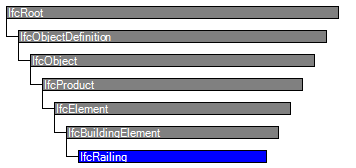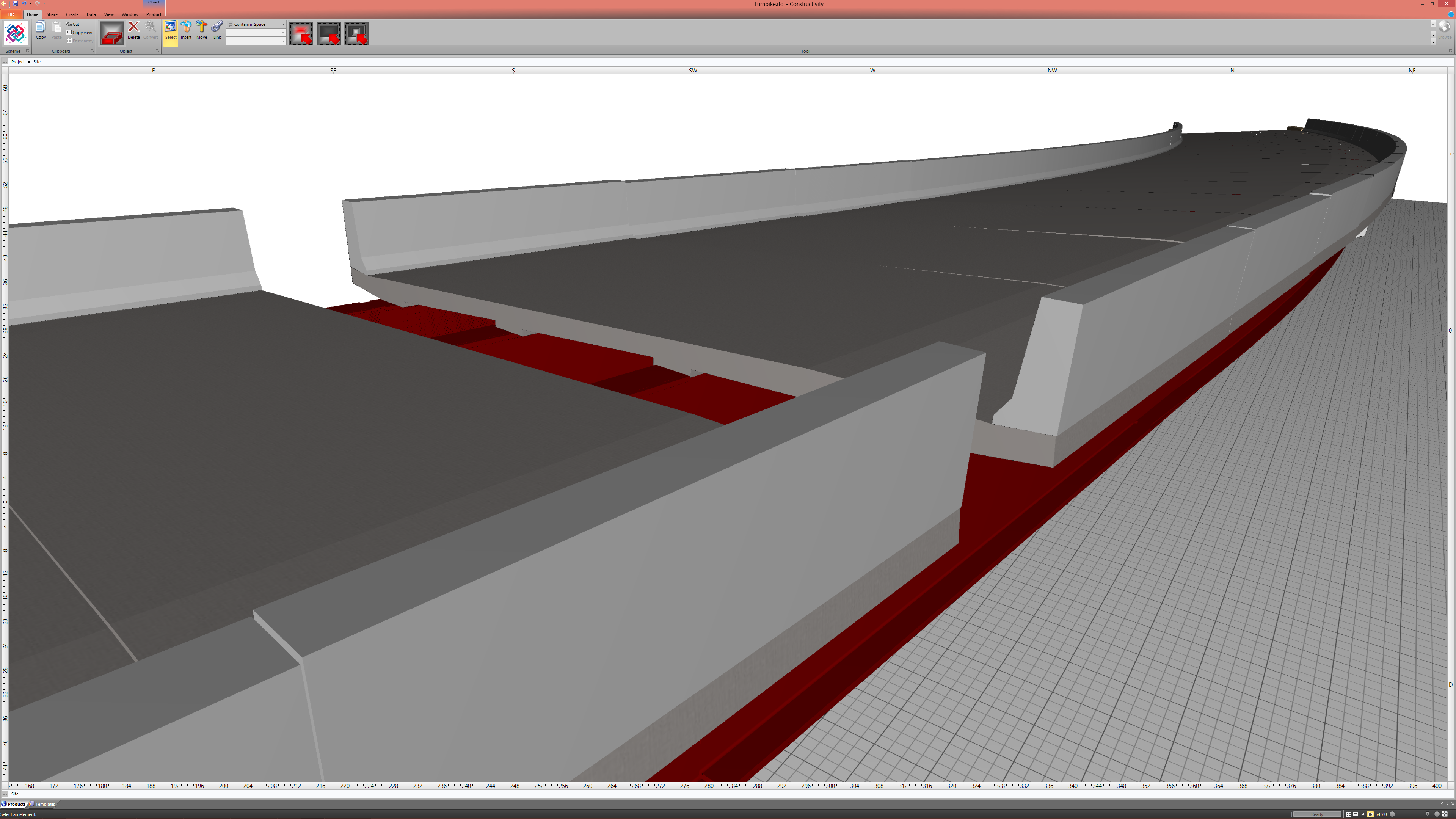Natural language names
 | Geländer |
 | Railing |
 | Garde corps |
 | Geländer |
 | Railing |
 | Garde corps |
| Item | SPF | XML | Change | Description | IFC2x3 to IFC4 |
|---|---|---|---|---|
| IfcRailing | ||||
| OwnerHistory | MODIFIED | Instantiation changed to OPTIONAL. | IFC4x1 to IFC4x2 | |
| IfcRailing | ||||
| PositionedFrom | ADDED |
The railing is a frame assembly adjacent to human circulation spaces and at some space boundaries where it is used in lieu of walls or to compliment walls. Designed to aid humans, either as an optional physical support, or to prevent injury by falling.
HISTORY New entity in IFC2.0
| # | Attribute | Type | Cardinality | Description | B |
|---|---|---|---|---|---|
| 9 | PredefinedType | IfcRailingTypeEnum | [0:1] |
Predefined generic types for a railing that are specified in an enumeration. There may be a property set given for the predefined types.
NOTE The PredefinedType shall only be used, if no IfcRailingType is assigned, providing its own IfcRailingType.PredefinedType. | X |
| Rule | Description |
|---|---|
| CorrectPredefinedType | Either the PredefinedType attribute is unset (e.g. because an IfcRailingType is associated), or the inherited attribute ObjectType shall be provided, if the PredefinedType is set to USERDEFINED. |
| CorrectTypeAssigned | Either there is no railing type object associated, i.e. the IsTypedBy inverse relationship is not provided, or the associated type object has to be of type IfcRailingType. |

| # | Attribute | Type | Cardinality | Description | B |
|---|---|---|---|---|---|
| IfcRoot | |||||
| 1 | GlobalId | IfcGloballyUniqueId | [1:1] | Assignment of a globally unique identifier within the entire software world. | X |
| 2 | OwnerHistory | IfcOwnerHistory | [0:1] |
Assignment of the information about the current ownership of that object, including owning actor, application, local identification and information captured about the recent changes of the object,
NOTE only the last modification in stored - either as addition, deletion or modification. | X |
| 3 | Name | IfcLabel | [0:1] | Optional name for use by the participating software systems or users. For some subtypes of IfcRoot the insertion of the Name attribute may be required. This would be enforced by a where rule. | X |
| 4 | Description | IfcText | [0:1] | Optional description, provided for exchanging informative comments. | X |
| IfcObjectDefinition | |||||
| HasAssignments | IfcRelAssigns @RelatedObjects | S[0:?] | Reference to the relationship objects, that assign (by an association relationship) other subtypes of IfcObject to this object instance. Examples are the association to products, processes, controls, resources or groups. | X | |
| Nests | IfcRelNests @RelatedObjects | S[0:1] | References to the decomposition relationship being a nesting. It determines that this object definition is a part within an ordered whole/part decomposition relationship. An object occurrence or type can only be part of a single decomposition (to allow hierarchical strutures only). | ||
| IsNestedBy | IfcRelNests @RelatingObject | S[0:?] | References to the decomposition relationship being a nesting. It determines that this object definition is the whole within an ordered whole/part decomposition relationship. An object or object type can be nested by several other objects (occurrences or types). | X | |
| HasContext | IfcRelDeclares @RelatedDefinitions | S[0:1] | References to the context providing context information such as project unit or representation context. It should only be asserted for the uppermost non-spatial object. | ||
| IsDecomposedBy | IfcRelAggregates @RelatingObject | S[0:?] | References to the decomposition relationship being an aggregation. It determines that this object definition is whole within an unordered whole/part decomposition relationship. An object definitions can be aggregated by several other objects (occurrences or parts). | X | |
| Decomposes | IfcRelAggregates @RelatedObjects | S[0:1] | References to the decomposition relationship being an aggregation. It determines that this object definition is a part within an unordered whole/part decomposition relationship. An object definitions can only be part of a single decomposition (to allow hierarchical strutures only). | X | |
| HasAssociations | IfcRelAssociates @RelatedObjects | S[0:?] | Reference to the relationship objects, that associates external references or other resource definitions to the object.. Examples are the association to library, documentation or classification. | X | |
| IfcObject | |||||
| 5 | ObjectType | - | This attribute is out of scope for this model view definition and shall not be set. | ||
| IsTypedBy | IfcRelDefinesByType @RelatedObjects | S[0:1] | Set of relationships to the object type that provides the type definitions for this object occurrence. The then associated IfcTypeObject, or its subtypes, contains the specific information (or type, or style), that is common to all instances of IfcObject, or its subtypes, referring to the same type. | X | |
| IsDefinedBy | IfcRelDefinesByProperties @RelatedObjects | S[0:?] | Set of relationships to property set definitions attached to this object. Those statically or dynamically defined properties contain alphanumeric information content that further defines the object. | X | |
| IfcProduct | |||||
| 6 | ObjectPlacement | IfcObjectPlacement | [0:1] | Placement of the product in space, the placement can either be absolute (relative to the world coordinate system), relative (relative to the object placement of another product), or constraint (e.g. relative to grid axes). It is determined by the various subtypes of IfcObjectPlacement, which includes the axis placement information to determine the transformation for the object coordinate system. | X |
| 7 | Representation | IfcProductRepresentation | [0:1] | Reference to the representations of the product, being either a representation (IfcProductRepresentation) or as a special case a shape representations (IfcProductDefinitionShape). The product definition shape provides for multiple geometric representations of the shape property of the object within the same object coordinate system, defined by the object placement. | X |
| ReferencedBy | IfcRelAssignsToProduct @RelatingProduct | S[0:?] | Reference to the IfcRelAssignsToProduct relationship, by which other products, processes, controls, resources or actors (as subtypes of IfcObjectDefinition) can be related to this product. | X | |
| IfcElement | |||||
| 8 | Tag | IfcIdentifier | [0:1] | The tag (or label) identifier at the particular instance of a product, e.g. the serial number, or the position number. It is the identifier at the occurrence level. | X |
| ConnectedTo | IfcRelConnectsElements @RelatingElement | S[0:?] | Reference to the element connection relationship. The relationship then refers to the other element to which this element is connected to. | ||
| HasOpenings | IfcRelVoidsElement @RelatingBuildingElement | S[0:?] | Reference to the IfcRelVoidsElement relationship that creates an opening in an element. An element can incorporate zero-to-many openings. For each opening, that voids the element, a new relationship IfcRelVoidsElement is generated. | X | |
| ConnectedFrom | IfcRelConnectsElements @RelatedElement | S[0:?] | Reference to the element connection relationship. The relationship then refers to the other element that is connected to this element. | X | |
| ContainedInStructure | IfcRelContainedInSpatialStructure @RelatedElements | S[0:1] | Containment relationship to the spatial structure element, to which the element is primarily associated. This containment relationship has to be hierachical, i.e. an element may only be assigned directly to zero or one spatial structure. | ||
| PositionedFrom | IfcRelPositions @RelatingElement | S[0:1] | Indicates a constrained placement, where the ObjectPosition must match positioning defined according to the referenced positioning element. | X | |
| IfcBuildingElement | |||||
| IfcRailing | |||||
| 9 | PredefinedType | IfcRailingTypeEnum | [0:1] |
Predefined generic types for a railing that are specified in an enumeration. There may be a property set given for the predefined types.
NOTE The PredefinedType shall only be used, if no IfcRailingType is assigned, providing its own IfcRailingType.PredefinedType. | X |
This entity may be used to model barriers of constant cross-section, or architectural railings.
Barriers may be defined as a constant cross-section placed along the alignment at either edge of a bridge deck or anywhere in between.
Guard rails and barriers are modelled as IfcRailing making use of custom profiles. Such barriers are modelled very similarly to girders, where an IfcArbitraryClosedProfileDef describes the cross-section, an IfcAlignment2DVertical describes the path, and an IfcFixedReferenceSweptAreaSolid captures the 3D shape.

|
Figure 65 — Bridge barrier model |
Railings may be connected to other railings (such as architectural railing onto guardrail) or to the slab of a bridge deck.
Object Typing
The Object Typing concept applies to this entity as shown in Table 45.
| ||
Table 45 — IfcRailing Object Typing |
| Exchange | ||||
|---|---|---|---|---|
| Import | O | |||
| Export | O |
Material Profile Set
The Material Profile Set concept applies to this entity.
For guard rails using profiles, the profile is defined using IfcArbitraryClosedProfileDef. The solid is constructed by sweeping the profile along IfcFixedReferenceSweptAreaSolid. Unlike the bridge deck, the profile of a guardrail typically does not vary along its path, so the profile can be defined statically and then swept along an alignment curve.
| Exchange | ||||
|---|---|---|---|---|
| Import | O | |||
| Export | O |
Constraint Association
The Constraint Association concept applies to this entity.
| Exchange | ||||
|---|---|---|---|---|
| Import | O | |||
| Export | O |
Element Decomposition
The Element Decomposition concept applies to this entity as shown in Table 46.
| ||||||||||
Table 46 — IfcRailing Element Decomposition |
Rebar (IfcReinforcingBar) and embedded conduit (IfcCableCarrierSegment) are linked using IfcRelAggregates where RelatingElement refers to the IfcRailing.
| Exchange | ||||
|---|---|---|---|---|
| Import | ||||
| Export |
Element Positioning
The Element Positioning concept applies to this entity as shown in Table 47.
| ||||||
Table 47 — IfcRailing Element Positioning |
| Exchange | ||||
|---|---|---|---|---|
| Import | O | |||
| Export | O |
| # | Concept | Model View |
|---|---|---|
| IfcRoot | ||
| Software Identity | Bridge View | |
| User Identity | Bridge View | |
| Object Ownership | Bridge View | |
| IfcObject | ||
| Property Sets for Objects | Bridge View | |
| IfcElement | ||
| Element Occurrence Attributes | Bridge View | |
| Product Local Placement | Bridge View | |
| Product Assignment | Bridge View | |
| IfcRailing | ||
| Object Typing | Bridge View | |
| Material Profile Set | Bridge View | |
| Constraint Association | Bridge View | |
| Element Decomposition | Bridge View | |
| Element Positioning | Bridge View | |
<xs:element name="IfcRailing" type="ifc:IfcRailing" substitutionGroup="ifc:IfcBuildingElement" nillable="true"/>
<xs:complexType name="IfcRailing">
<xs:complexContent>
<xs:extension base="ifc:IfcBuildingElement">
<xs:attribute name="PredefinedType" type="ifc:IfcRailingTypeEnum" use="optional"/>
</xs:extension>
</xs:complexContent>
</xs:complexType>
ENTITY IfcRailing
SUBTYPE OF (IfcBuildingElement);
PredefinedType : OPTIONAL IfcRailingTypeEnum;
WHERE
CorrectPredefinedType : NOT(EXISTS(PredefinedType)) OR
(PredefinedType <> IfcRailingTypeEnum.USERDEFINED) OR
((PredefinedType = IfcRailingTypeEnum.USERDEFINED) AND EXISTS (SELF\IfcObject.ObjectType));
CorrectTypeAssigned : (SIZEOF(IsTypedBy) = 0) OR
('IFCSHAREDBLDGELEMENTS.IFCRAILINGTYPE' IN TYPEOF(SELF\IfcObject.IsTypedBy[1].RelatingType));
END_ENTITY;